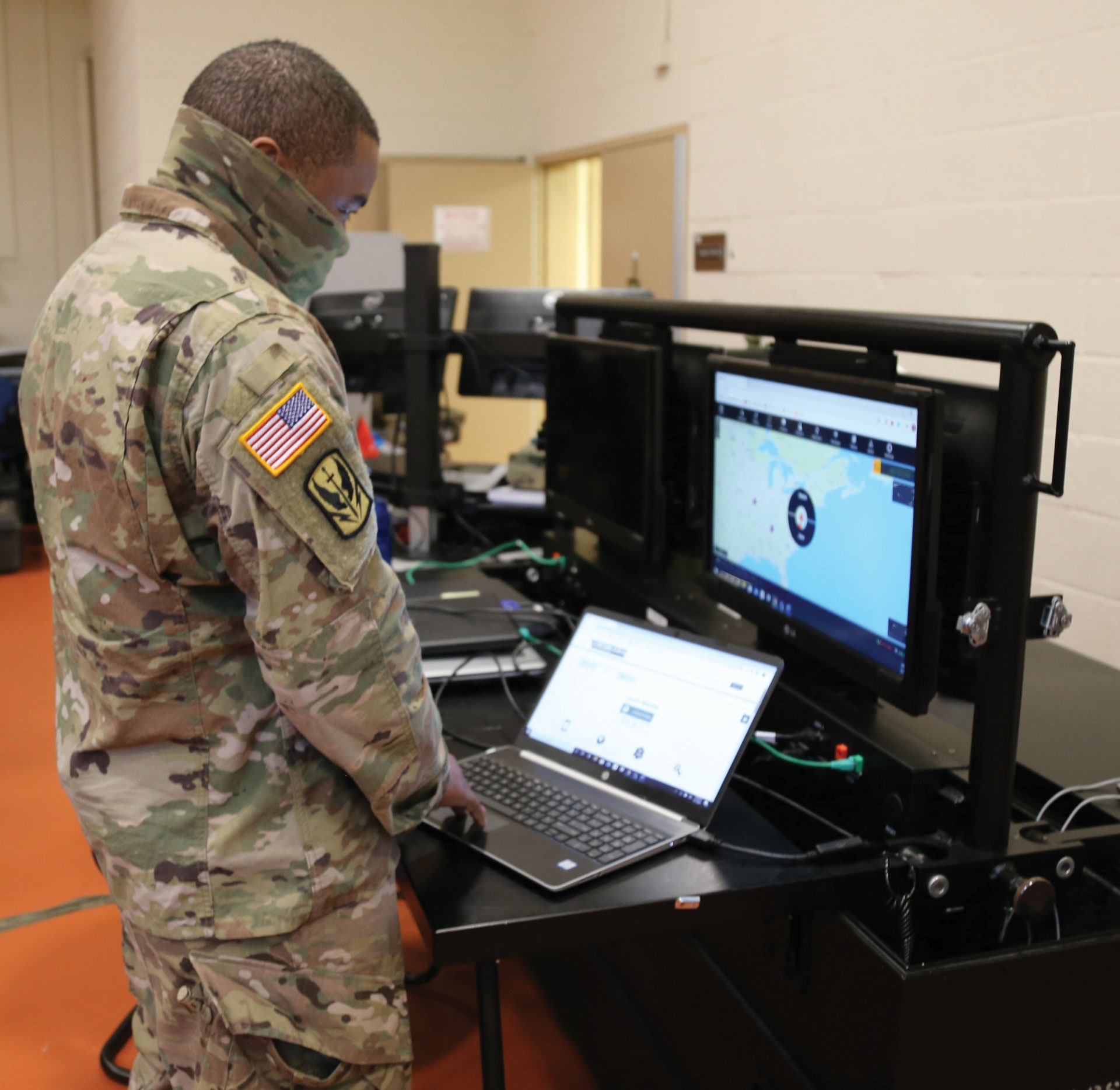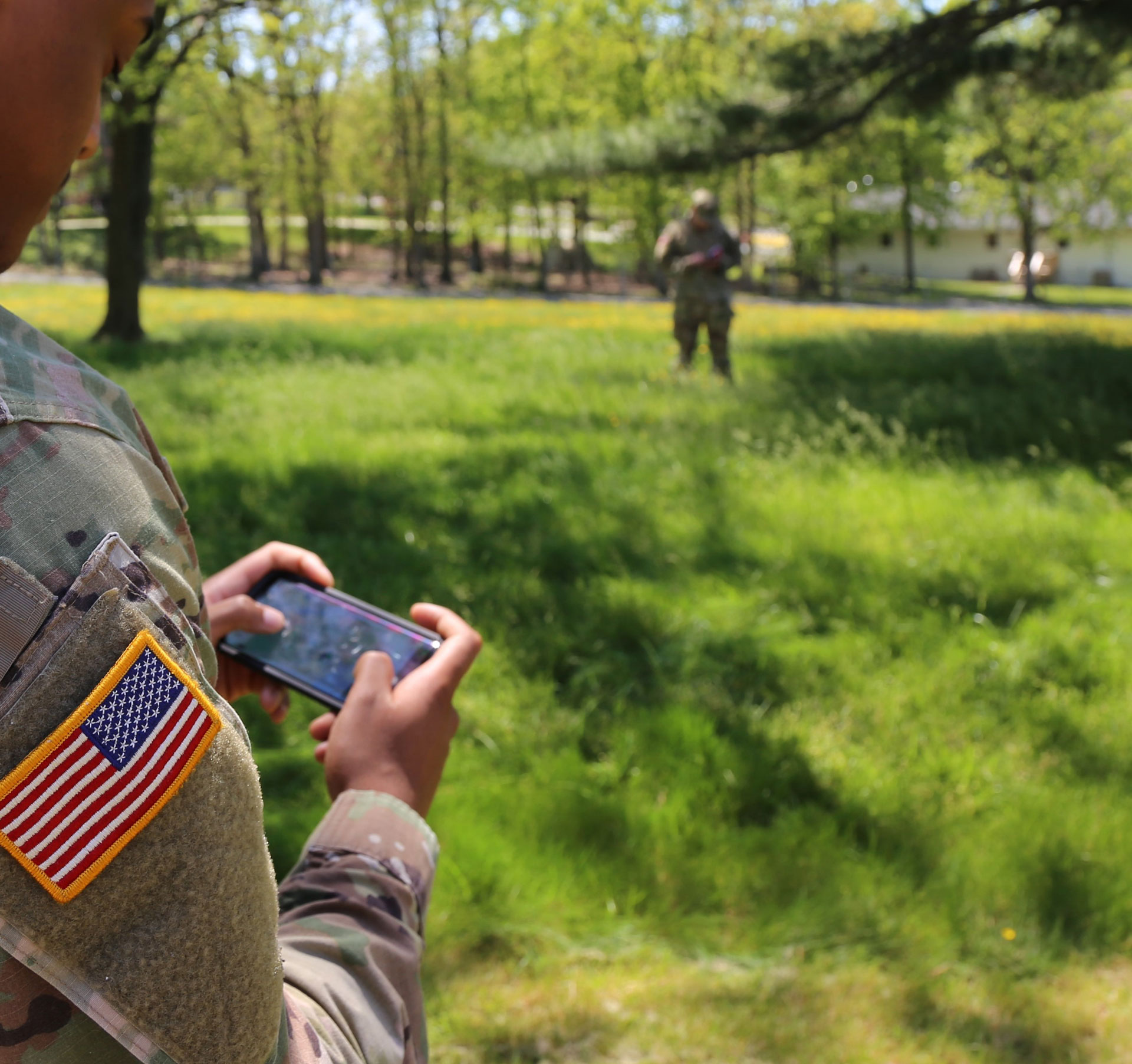
LOAD ‘EM UP: Sgt. Cedric Melton, 63rd Expeditionary Signal Battalion (ESB), 35th Signal Brigade inspects the vehicles before they are loaded on a plane at Hunter Army Airfield, Georgia. The 63rd ESB is moving personnel and equipment in support of U.S. Northern Command and ARNORTH’s request for defense support of civil authorities in response to the COVID-19 pandemic by providing communications support to areas affected by COVID-19. (Photo by Staff Sgt. Joseph Truckley)
C5ISR COVID-19 Response Equipping Team keeps Army’s units connected.
by Col. Shane Taylor, Col. Troy Denomy, Col. Lesley Kipling and Amy Walker
When the world was brought to a sudden halt at the onset of the COVID-19 pandemic last spring, a team of experts from the Army’s network development and acquisition program offices stepped into high gear. Their unified efforts ensured that U.S. Soldiers supporting local and state governments were equipped with the latest situational awareness and communication systems needed to support their unfolding pandemic response missions.
Just as it would in tactical battlefield operations, the team understood that providing both dismounted Soldiers and headquarters elements with real-time situational awareness would enable collaboration and faster, more accurate decision-making in the fight against COVID-19. Getting first responders and essential personnel to the right place at the right time with the right information and supplies was the only way to take ground.
Through a cohesive team-of-teams approach, the Army’s network modernization community—including the Program Executive Office for Command, Control, Communications – Tactical (PEO C3T), PEO Soldier, the Network Cross-Functional Team and Communications-Electronics Command (CECOM), with the Army’s Chief Information Officer/G-6 and G-3/5/7—proactively stood up the Command, Control, Computers, Communications, Cyber, Intelligence, Surveillance and Reconnaissance (C5ISR) COVID-19 Response Equipping Team, in March 2020. The team worked closely with U.S. Northern Command and U.S. Army North (ARNORTH), the Army National Guard and the U.S. Army Corps of Engineers to rapidly provide COVID-19 response units with the latest network communications capability, integration expertise and robust help-desk services to augment and enhance their organic communications systems.
Aligned under U.S. Northern Command (NORTHCOM), ARNORTH serves as the joint forces land component command for all federal ground troops in the continental United States in support of homeland defense and defense support of civil authorities missions. ARNORTH is NORTHCOM’s designated lead component to work with the Federal Emergency Management Agency (FEMA) to align federal military support to validated requests for assistance. At the height of its response in April 2020, NORTHCOM had more than 9,000 service members deployed across the country and supported over 130 FEMA missions. Additionally, in the early phase of the COVID-19 response, as U.S. experts were still trying to understand the coronavirus and how the pandemic would evolve, the Army regionally aligned four task forces, where Army National Guard units and other elements supported a wide mix of mission sets including medical, communications and logistics. The Army National Guard had more than 40,000 Guardsmen on orders supporting state and federal missions during the peak of the COVID response. With so many moving parts and players, communication and situational awareness were absolutely critical.
The C5ISR COVID-19 Response Equipping Team’s combined strengths ensured that both front-line and support elements possessed the data exchange and common operational picture they need to successfully collaborate and support the pandemic response efforts. The team delivered capabilities and services that were already part of Army programs, repurposed capability in innovative ways to support unique COVID-19 mission sets, and rapidly procured new communication systems as needed. They also ensured help desk functions were established to troubleshoot tactical network communication issues as they arose in the field. Their rapid delivery of enhanced network applications and communications equipment led to a better understanding of regional COVID-19 impacts and assisted commanders working with FEMA and local governments in their response efforts.

NEW WAYS TO COMMUNICATE: CRSSTALK is a map-based, situational awareness software application that can be used across multiple platforms to provide tactical capabilities for military and federal government operations. (U.S. Army photo by Amy Walker)
A STRONG NETWORK COMMUNICATIONS ‘PACE’ PLAN
Military, government and non-government agencies, and first responders leveraged the robust U.S. commercial network infrastructure as their primary means of enabling voice, video and data exchange in COVID-19 response efforts. Working with ARNORTH and Army National Guard network managers and planners, the team helped identify the rest of the primary, alternate, contingency and emergency communications plan, and assessed unit and system readiness, to ensure redundant backups in case the primary commercial communication infrastructure got overloaded or damaged.
To securely exchange network data between commercial and military networks in support of ARNORTH and Army National Guard missions, the Army leveraged its existing network gateways. These included Commercial Coalition Equipment (CCE) network enclaves, regional hub nodes (RHNs) and the Global Agile Integrated Transport (GAIT) mesh network design that interconnects global data transport. At the height of the response efforts, RHNs and GAIT supported over 100 GAIT missions in total, with 72 simultaneous ARNORTH and Army National Guard COVID-19 missions.
Additionally, in cases where needed, Army National Guard units used their Disaster Incident Response Emergency Communications Terminal (DIRECT) tool suite, which includes CCE, to connect to the U.S. commercial networks. CCE is a critical component in the DIRECT system, which also enables interconnection between cell, landline and Voice over Internet Protocol (VoIP) calls, between various military and first responder radios to enable a seamless collaboration and synchronization across the entire mission. The DIRECT equipment kit enables Army National Guard units to provide commercial phone, internet access, Wi-Fi and 4G LTE to military, government and non-governmental first responders as needed.
The team worked across the Army’s materiel community to provide systems as they were requested by units, such as military Secure Wireless equipment requested by ARNORTH Headquarters, at Fort Sam Houston, Texas. Secure Wireless provided rapid network connectivity for personnel as they moved through ARNORTH headquarters for deployments around the country. The team also provided the system to ARNORTH mobile response teams so they could scale up their networks to cover a large area wherever they were deployed. Adhering to travel restrictions and social distancing policies, the team provided remote Secure Wireless training via Microsoft Teams to the ARNORTH G-6 network technicians, as well as client software, training support packages, and an updated wiring diagram, via secure file exchange platforms.

SATELLITES ON BOARD: A member of the Hunter Army Airfield Air movement team loads a satellite on a plane at Hunter Army Airfield, Georgia. (Photo courtesy of PEO C3T Public Affairs)
CALL THE 24/7 HELP DESK
To assist National Guard and ARNORTH with tactical network initialization, integration, system troubleshooting and maintenance issues, the team stood up a help desk to provide 24/7 network assistance. The collaborative effort among PEO Soldier, PEO C3T and CECOM leveraged the existing Mission Command Support Center, at Aberdeen Proving Ground, Maryland, which primarily assists with network management and troubleshooting of the Army’s Blue Force Tracker capability. The help desk served as a single point of entry for COVID-19 response units to request technical assistance from PEO C3T and CECOM experts on all Army tactical network devices and communications systems.

ESSENTIAL FEEDBACK: Soldiers from the Maryland Army National Guard 58th Troop Command Headquarters and Headquarters Detachment use CRSSTALK to support COVID-19 response efforts at Adelphi, Maryland. The unit is providing feedback as part of a CRSSTALK pilot to enable the Army to continue to enhance capability. (U.S. Army photo by Amy Walker)
WE’VE GOT AN APP FOR THAT
A key effort led by PEO Soldier adapted and delivered—in less than three weeks—a civilian version of the Army’s Tactical Assault Kit software, to provide National Guard and other agencies with up-to-date COVID-19 data on a common software application that can run off personal devices. Using a combination of fielding new smartphones capable of using the applications, and a “bring your own device” strategy, the Contingency Response Situational Awareness/Situational Understanding Tactical Applications Leader Kit effort (CRSSTALK), delivered a line of map-based, situational awareness software applications across multiple platforms, to provide tactical capabilities for military and federal government operations. This effort was coordinated with ARNORTH, the Army National Guard and individual states, and 20 states and territories received the CRSSTALK capability.
The team provided ARNORTH and Army National Guard personnel with applications and communications equipment that led to a better understanding of regional COVID-19 impacts and enabled a common operational picture for commanders and government and local agencies to collaborate more closely. Units used the Mission Command Support Center to enable interoperability across a wide range of military and civilian devices, and to virtually train supporting units on the latest applications. Most important, the support center, in conjunction with Johns Hopkins University, constructed a dashboard to display relevant COVID-19 data on a common map, enhancing collaboration among first responders, local and national agencies and Army National Guard personnel.
IMPROVED READINESS TO SUPPORT AN UNKNOWN FUTURE
When the U.S. moves into various phases of recovery, elements of the C5ISR COVID-19 Response Equipping Team continue to communicate with ARNORTH and the Army National Guard to ensure they have the communications capability needed to support pandemic response efforts. As of October 2020, with the onset of colder weather and a potential for a spike in COVID-19 cases, the team remains ready to provide additional support and capability as needed to enable situational awareness, better logistics data and enhanced network connectivity.
The network enhancements and lessons learned from this rapid homeland response effort can be leveraged to support future homeland response missions, whether COVID-19 related or other natural or man-made disasters. As on any battlefield, communication remains the No. 1 priority in all future domestic operations.
For more information, go to http://peoc3t.army.mil/c3t/ or contact the PEO C3T Public Affairs Office at 443-395-6489 or usarmy.APG.peo-c3t.mbx.pao-peoc3t@mail.mil.
COL. SHANE TAYLOR is the project manager for Tactical Network at PEO C3T. He earned an M.S. in industrial engineering and operations management from Clemson University; an M.S. in business administration from Penn State University, an M.A. in national security and resource strategy from the Dwight D. Eisenhower School for National Security and Resource Strategy of National Defense University, and a B.S. in business administration from Oklahoma State University.
COL. TROY DENOMY is the project manager for Close Combat Squad for PEO Soldier. He is a graduate of the U.S. Army War College. He holds an M.S. from George Washington University and a B.A. from Wofford College.
COL. LESLEY KIPLING is a signal officer and serves as the Mission Command Portfolio lead and Army National Guard liaison officer for the Network Cross-Functional Team. She holds a master’s degree in communication and public policy from American University and an M.S. in government information leadership from National Defense University.
AMY WALKER has been the public affairs lead at Project Manager Tactical Network for the last 10 years, and was the public affairs lead at PEO C3T for the previous two. She has covered a majority of the Army’s major tactical network transport modernization efforts, including Army, joint and coalition fielding and training events worldwide. She holds a B.A. in psychology, with emphasis in marketing and English, from the College of New Jersey. A frequent contributor to Army AL&T, her last article appeared in the Summer 2020 edition.
Read the full article in the Winter 2021 issue of Army AL&T magazine.
Subscribe to Army AL&T – the premier source of Army acquisition news and information.
![]()


